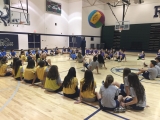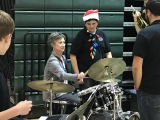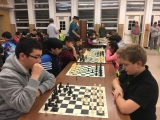-
Category 1
Selected in 2018
-
Grades: 6 - 8
School Setting: urban
Town Population: 89,320
Student Enrollment: 1
Student Demographics:
Black/African American: 5%
Teacher/Student Ratio: 1:30
White/Caucasian: 30.3%
Hispanic: 57.6%
Hawaiian/Pacific Islander: 0.2%
Asian: 1.4%
Native American: 5.3%
Other: 0.2%
% Reduced Lunch: 51%
% ELL Learners: 4.9%
Founded: 2009 -
PRINCIPAL:
Lynda Kitts -
CONTACT:
1600 Loma Colorado Blvd NE
Rio Rancho, NM 87144
505-962-4628
lynda.kitts@rrps.net
Rio Rancho Middle School
Rio Rancho, NM
We empower staff members to be both informal and formal leaders.
- Describe specific programs in place to ensure that families are involved in the success of your school and students.
- We strongly support the PBiS Framework which develops a variety of ways to celebrate student success, both academically and behaviorally. Electronic access (read-only) to teachers’ gradebooks so parents/guardians can view their students’ progress in real-time, Google classrooms: Students have access to their teacher and classroom from anywhere; if they are out ill or out of town they can sign into their classes and participate, interactive websites and teacher blog pages: students can communicate with their teachers in a variety of ways when they are not in school; students and their parents/guardians have access to notes, examples, and resources.
- Describe the most successful activity your school has initiated to strengthen ties to your community.
-
Many of our clubs participate in “paying it forward.” Each quarter they choose a project to help our school and community; some projects have included the following: Eagle Scout projects which included designing and building a safe walkway for students who walk home from our school, campus clean-up (students and staff meet on a Saturday to clean-up our campus and the surrounding streets), volunteering at our local Roadrunner Food Bank, various collections for families in need, pennies for patients, food drives, etc., each Friday, students in need are sent home with backpacks filled with snacks for the weekend, students visit the local preschool and read to children, students visit a local retirement home to play board games with residents.
- Describe your philosophy of school change or improvement.
- School change/improvement must be on-going, and include stakeholders from all levels. Communication should be transparent, consistent, and honest. Staff members must be empowered to take reasonable risks, participate in, and provide professional development opportunities as they are the experts. Regardless of the role each of our staff members play it takes all of us to open the doors and be successful.
- What are your school’s top two goals for the next year?
- Our top two goals for the next year are the following: Continued academic and emotional growth for all of our students, and continued retention of a staff who cares for our students and each other.
- What is the single most important factor in the success of your school that others could replicate?
- Staff members (at all levels) knowing they are trusted, appreciated, and recognized.
- Describe the program or initiative that has had the greatest positive effect on student achievement, including closing achievement or opportunity gaps, if applicable.
- It is difficult to choose just one! Our staff is very cohesive; we have very little turnover (most staff members who leave are retiring or moving to another state). This creates stability for our students and our staff members. As a result, our PLCs are strong, our grade levels work collaboratively, and staff members know we want their feedback… good or bad… which allows us to have open and honest conversation, which leads to positive changes for the entire school community.
- Explain how ESEA federal funds are used to support your improvement efforts.
- ESEA federal funds help support our improvement efforts in the following supplemental ways: before and after-school tutoring opportunities, increased access to technology, increased classroom resources, and additional staffing positions to help us better meet the needs of our students.
- Identify the critical professional development activities you use to improve teaching and student learning.
- Part of our climate survey includes asking staff members what types of professional development they feel would be helpful. We use this information to drive our professional development for the year. The following opportunities are just a few examples: Staff-led professional development (i.e.: interactive notebooks, Chromebook training, classroom management strategies, working with students who have special needs), on-going training from our ed tech, SEILs (Special Education Instructional Leaders,) counselors, social workers, content leaders, and specialized programs), and staff are provided time to observe their peers.
- Describe how data is used to improve student achievement and inform decision making.
-
Student achievement data, discipline data, attendance data, and surveys administered to the staff and community informs our focus areas for the year. This data is also used to build a master calendar most conducive to the success of all students (e.g. grade/core teachers share the same prep period), and is used to place students appropriately, such as in intervention classes, if necessary. A structured school leadership team deploys into smaller grade level and/or content Professional Learning Communities to have focused and targeted conversations and action steps toward the school-wide goal. Individual responsibility is structured through annual Professional Development Plans (PDPs) that are aligned to the school focus areas. Evidence based conversations and instructional decisions are made in alignment to the shared goals. Formative data is used day to day to make informed decisions regarding instructional practices.
- Describe your school culture and explain changes you’ve taken to improve it.
- Our school culture is one of family; together we enjoy celebrations, and together we lift each other up in times of struggle. We empower staff members to be both informal and formal leaders. Three times each year staff are asked to complete an anonymous “climate survey;” once in the Fall, once in the Winter, and the third at the end of the school year. The school Administrative team responds to survey results, and uses the feedback to ensure the continuous improvement of our school.
Stats
-
Category 1
Selected in 2018
-
Grades: 6 - 8
School Setting: urban
Town Population: 89,320
Student Enrollment: 1
Student Demographics:
Black/African American: 5%
Teacher/Student Ratio: 1:30
White/Caucasian: 30.3%
Hispanic: 57.6%
Hawaiian/Pacific Islander: 0.2%
Asian: 1.4%
Native American: 5.3%
Other: 0.2%
% Reduced Lunch: 51%
% ELL Learners: 4.9%
Founded: 2009 -
PRINCIPAL:
Lynda Kitts -
CONTACT:
1600 Loma Colorado Blvd NE
Rio Rancho, NM 87144
505-962-4628
lynda.kitts@rrps.net










